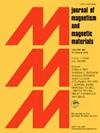共同增强 Nd-Fe-B 晶界扩散磁体界面粘附力和矫顽力的策略:丝网印刷中使用的 TbH3 纳米粉体
IF 2.5
3区 材料科学
Q3 MATERIALS SCIENCE, MULTIDISCIPLINARY
引用次数: 0
摘要
采用丝网印刷技术(SPT),以 TbH3 和 TbF3 纳米粉体为扩散源,进行晶界扩散烧结 Nd-Fe-B 磁体。与 TbF3 晶界扩散(FGBD)涂层相比,TbH3 晶界扩散(HGBD)涂层与磁体表面的附着力更好。当增重比为 1.0 wt%时,HGBD 磁体在非加压热处理条件下实现了 11.07 kOe 的矫顽力增量,同时有效控制了磁体的残余 C 和 O 元素。然而,由于涂层与磁体表面之间的附着力较差,导致磁体内部残留更多的 C 和 O 元素,因此 FGBD 磁体必须经过加压热处理才能提高矫顽力。此外,FGBD 磁体的矫顽力仅提高了 7.96 kOe。与 FGBD 磁体相比,铽元素在 HGBD 磁体中扩散得更深,形成了更多的(钕、铽)2Fe14B-Nd2Fe14B 核壳结构。核壳结构的形成大大增强了反向畴的成核场,从而提高了矫顽力。因此,HGBD 磁体具有更高的矫顽力。此外,与原始磁体和 FGBD 磁体相比,HGBD 磁体具有更好的矫顽力温度稳定性。使用 TbH3 纳米粉体作为 SPT 的扩散源可以获得更高的磁性能,并简化了无压工艺。本文章由计算机程序翻译,如有差异,请以英文原文为准。
Strategy for co-enhancement of interface adhesion and coercivity of Nd-Fe-B grain boundary diffusion magnet: TbH3 nanopowders used in screen printing
Screen printing technology (SPT) was applied to conduct grain boundary diffusion sintered Nd-Fe-B magnets using TbH3 and TbF3 nanopowders as diffusion sources. TbH3 grain boundary diffusion (HGBD) coating had better adhesion to the magnet surface than TbF3 grain boundary diffusion (FGBD) coating. When the weight gain ratio was 1.0 wt%, the HGBD magnet achieved a coercivity increment of 11.07 kOe under non-pressurized heat treatment, while effectively controlling the magnet’s residual C and O elements. However, pressure heat treatment was necessary for the FGBD magnet to improve the coercivity due to the poor adhesion between the coating and the magnet surface, resulting in more residual C and O elements inside the magnet. Moreover, the coercivity of the FGBD magnet only increased by 7.96 kOe. Compared to the FGBD magnet, Tb diffused deeper into the HGBD magnet and formed more (Nd, Tb)2Fe14B-Nd2Fe14B core–shell structures. The formation of core–shell structures greatly enhanced the nucleation field of the reverse domain, thereby increasing the coercivity. Hence, the HGBD magnet had a higher coercivity increment. In addition, the HGBD magnet possessed better coercivity temperature stability than the original and FGBD magnets. Using TbH3 nanopowders as a diffusion source for SPT can achieve higher magnetic properties and simplified processes without pressure.
求助全文
通过发布文献求助,成功后即可免费获取论文全文。
去求助
来源期刊

Journal of Magnetism and Magnetic Materials
物理-材料科学:综合
CiteScore
5.30
自引率
11.10%
发文量
1149
审稿时长
59 days
期刊介绍:
The Journal of Magnetism and Magnetic Materials provides an important forum for the disclosure and discussion of original contributions covering the whole spectrum of topics, from basic magnetism to the technology and applications of magnetic materials. The journal encourages greater interaction between the basic and applied sub-disciplines of magnetism with comprehensive review articles, in addition to full-length contributions. In addition, other categories of contributions are welcome, including Critical Focused issues, Current Perspectives and Outreach to the General Public.
Main Categories:
Full-length articles:
Technically original research documents that report results of value to the communities that comprise the journal audience. The link between chemical, structural and microstructural properties on the one hand and magnetic properties on the other hand are encouraged.
In addition to general topics covering all areas of magnetism and magnetic materials, the full-length articles also include three sub-sections, focusing on Nanomagnetism, Spintronics and Applications.
The sub-section on Nanomagnetism contains articles on magnetic nanoparticles, nanowires, thin films, 2D materials and other nanoscale magnetic materials and their applications.
The sub-section on Spintronics contains articles on magnetoresistance, magnetoimpedance, magneto-optical phenomena, Micro-Electro-Mechanical Systems (MEMS), and other topics related to spin current control and magneto-transport phenomena. The sub-section on Applications display papers that focus on applications of magnetic materials. The applications need to show a connection to magnetism.
Review articles:
Review articles organize, clarify, and summarize existing major works in the areas covered by the Journal and provide comprehensive citations to the full spectrum of relevant literature.
 求助内容:
求助内容: 应助结果提醒方式:
应助结果提醒方式:


